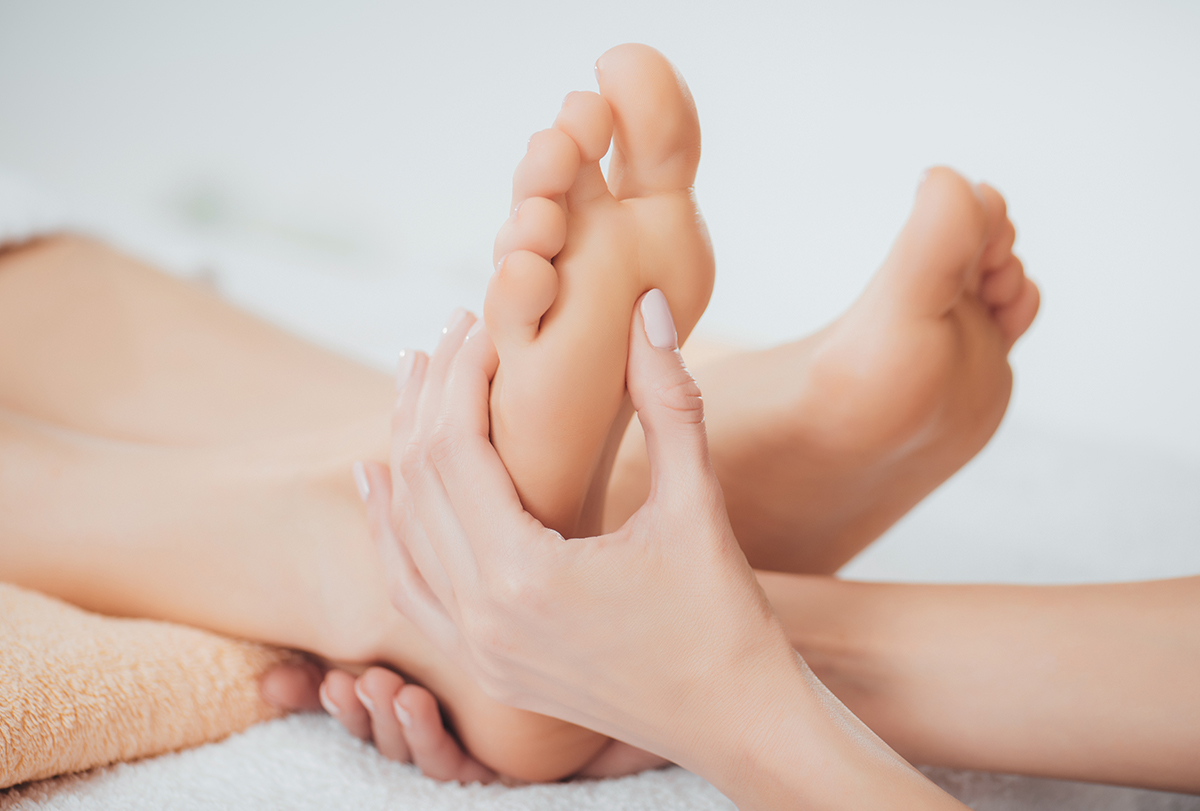In this article:
Poorly managed diabetes causes nerve damage in different parts of the body, especially the extremities. This is known as diabetic neuropathy which can give rise to a lot of pain and discomfort.

If left untreated, the condition tends to get progressively worse and starts affecting your internal organs as well as autonomous nervous system. This is why it is important to control it in the early stages.
The best way to treat and prevent diabetic neuropathy is to keep your blood sugar under control. Plus, there are certain natural interventions that can help relieve the symptomatic discomfort associated with this condition.
Natural Ways to Relieve Diabetic Nerve Pain
Here are some things you can do at home to alleviate the pain and discomfort caused by diabetic nerve damage:
1. Apply capsaicin cream
Capsaicin has analgesic and anti-inflammatory properties that can help reduce nerve pain due to diabetes. When applied topically, capsaicin cream produces a warming sensation that helps reduce pain.
In a clinical study published in Acta Diabetologica, researchers found that when topical capsaicin was applied to the feet of patients with symptomatic diabetic neuropathy, capsaicin helped to improve the symptoms, including pain perception threshold. (1)
There are over-the-counter pain-relieving topical capsaicin creams available in concentrations ranging from 0.025% to 0.075% capsaicin. All you need to do is apply the cream to the pain-affected areas two to three times a day. However, be sure not to apply capsaicin cream on broken or irritated skin.
2. Regular exercise can be beneficial

To deal with diabetic nerve pain, regular exercise is a must.
Exercising helps improve blood flow to your damaged nerves and helps nourish the damaged nerves back to normal condition. Exercising also helps lower blood sugar, increases your tolerance levels for the nerve pain, and keeps your diabetes in control.
A 2015 study published in Pain Medicine found that perceived pain interference may be reduced following an aerobic exercise intervention among people with painful diabetic peripheral neuropathy, without a change in pain intensity. (2)
Another study published in the Journal of Diabetes and its Complications in 2012 reports improvements in neuropathic and cutaneous nerve fiber branching following supervised exercise in people with diabetic peripheral neuropathy. (3)
To reap the benefits of exercise, there is no need to join a gym and do a rigorous exercise routine. You can simply go walking or swimming.
3. Drink ginger tea
Ginger has been used as an herbal therapy in Chinese and Indian medicine for centuries to help relieve pain.
Its powerful anti-inflammatory substance known as gingerol makes it an effective remedy for diabetic nerve pain. It can even increase mobility among those with chronic pain. Ginger also helps to manage blood sugar levels.
A study published in the Iranian Journal of Pharmaceutical Research in 2015 reports that ginger powder supplements may help improve fasting blood sugar. In this study, participants were given 2 grams of ginger every day for 12 weeks, and it helped to lower the levels of hemoglobin A1c, apolipoprotein B, apolipoprotein A-1, and malondialdehyde. (4)
How to consume:
- Try to drink 2–3 cups of ginger tea daily. To make the tea, boil 1 cup of water and add 1 tablespoon of chopped ginger slices to it. Let it steep for 5–10 minutes, and your tea is ready.
- Also, take ginger supplements but only after consulting your doctor.
4. Healing potential of alpha lipoic acid

Alpha-lipoic acid (ALA), a kind of fatty acid, is another possible alternative remedy to treat diabetes-related nerve pain.
First of all, ALA helps fight free radicals, which cause cell damage. Second, it helps restore the functioning of damaged nerve cells and prevents further damage. It also helps the body to be more sensitive to insulin.
A 2009 study published in the Review of Diabetic Studies reports that ALA can help improve motor-nerve conduction velocity in experimental diabetic neuropathy and protects the peripheral nerves from ischemia in rats. (5)
Another study published in the Netherlands Journal of Medicine in 2010 found that when given intravenously at a dosage of 600 mg once daily over a period of three weeks, ALA leads to a significant and clinically relevant reduction in neuropathic pain (grade of recommendation A). (6)
You can find ALA in foods like Brussels sprouts, broccoli, peas, rice bran, and potatoes. You can even take supplements but only after consulting your doctor.
5. Massage the affected area
Diabetic nerve pain can be taken care of with simple massage therapy. Gentle massaging along the length and sides of the affected area will help improve blood circulation and aid in the healing of damaged nerves. Massage even aids in improving the range of motion.
A study published in Diabetes Spectrum suggests that massage may have a positive effect on blood glucose levels and symptoms of diabetic neuropathy. (7)(8)
Another 2017 study published in the Journal of Nursing Scholarship reports that aromatherapy massage is a simple and effective nonpharmacological nursing intervention that can be used to manage neuropathic pain and improve the quality of life in patients with painful neuropathy. (9)
How to perform:
- Apply some lukewarm mustard, olive, or coconut oil on the affected area.
- Massage the area with long, gentle strokes for 5 to 10 minutes.
- After the massage, wrap the area with a warm towel.
- Do this several times a day.
6. Limit your alcohol intake

Drinking occasionally is not bad, but drinking too much alcohol is associated with diabetic neuropathy. In fact, a high dose of alcohol is toxic to your nerves and can result in severe nerve damage and may worsen the neuropathy.
Excessive drinking even makes your body deficient in some nutrients and hence should be completely avoided.
A study published in Alcohol Health & Research World reports that occasional episodes of alcohol consumption generally do not worsen blood sugar control in people with diabetes and may even have beneficial effects. However, regular consumption of even moderate amounts of alcohol clearly interferes with diabetic blood sugar control and increases the risk of peripheral neuropathy. (10)(11)
Excessive drinking also increases the risk of alcoholic neuropathy.
A study published in the British Journal of Clinical Pharmacology reports that alcoholic neuropathy involves coasting caused by damage to nerves that results from long-term excessive drinking of alcohol and is characterized by spontaneous burning pain, hyperalgesia, and allodynia. (12)
Limit alcohol to no more than four drinks a week, and if possible, avoid it completely.
7. Quit smoking
If you suffer from diabetic nerve pain, it is time to quit smoking. Smoking causes your blood vessels to constrict, impairing your circulation. This, in turn, causes the peripheral nerves to get less nutrient-rich blood, which can lead to more pain.
A study published in the Journal of General Internal Medicine in 2015 reports smoking to be associated with an increased risk of diabetic pain neuropathy in persons with diabetes. However, more studies are needed to test whether this association is causal and whether smoking cessation reduces the risk of diabetic pain neuropathy in adults with diabetes. (13)
Another 2017 published in the Turkish Society of Algology found smoking as a risk factor for neuropathic pain. (14)
According to this study, the possibility of neuropathic pain increases as the duration of smoking and addiction level increase, and with diabetes, this rate increases even more. It is extremely important that smokers should be informed regarding these facts and possibilities. (15)
8. Relieve pain with chiropractic care

Chiropractic care is an increasingly popular natural treatment for the treatment of nerve pain associated with diabetes.
Different techniques including palpation, pressure, massage, exercise programs, and lifestyle counseling are used together to help reduce pain, swelling, and inflammation.
These techniques help a lot in improving the range of motion by loosening the tight muscles, aiding in circulation and nerve connection. Moreover, it is very relaxing for the whole body.
According to a 2015 report by Diabetes News Journal, chiropractic care is an effective treatment for peripheral neuropathy because it targets the root cause of the patient’s pain symptoms. (16)
Always make sure that you choose a qualified and reputed chiropractic center.
9. Acupuncture can provide relief
Like chiropractic care, acupuncture is another effective option to treat diabetic nerve pain.
In this kind of traditional Chinese therapy, certain points on the body are stimulated with needles to help relax the tight muscles, boost blood circulation, and heal damaged nerves. This, in turn, reduces pain.
A 2010 study published in the Journal of Acupuncture and Meridian Studies reports that acupuncture may be clinically useful for the radical treatment of diabetic peripheral neuropathy. (17)
Another study published in the Journal of Translational Medicine & Research in 2017 suggests that acupunctural therapy has the potential to treat a range of type 2 diabetes symptoms, including hyperglycemia, diabetic neuropathy, and other pain-related complications. (18)(19)
Always have acupuncture done by a skilled and experienced acupuncturist.
10. Take a warm water bath

Note: The following remedy is neither backed by scientific evidence nor reviewed by our health experts. Nonetheless, a number of general users have reported an improvement in their condition using this anecdotal remedy.
One of the easiest natural home remedies for getting relief from diabetic nerve pain is taking a warm bath.
Heat provides comfort and helps the healing process, as it improves blood circulation to the site of the damaged nerve. Moreover, warm water bath makes you get rid of stress and feel relaxed. (20)
Enjoy a warm water bath twice daily for 20 minutes. However, always remember to check the water temperature with your hands instead of your foot before stepping into a bathtub.
For added benefit, you can put 1 cup of Epsom salt in your bathwater, once or twice a week.
Prevention of Diabetic Nerve Pain
Some of the things you can do to prevent diabetic nerve pain include the following:
- Maintain your blood sugar levels within the target range by religiously following the doctor-stipulated medication regimen. Such steady glycemic control will help prevent or mitigate diabetes-induced nerve damage and, thereby, delay the onset of neuropathy.
- Avoid a sedentary lifestyle by engaging in some form of physical activity every now and then.
- Shed the excess weight to keep your cholesterol and blood glucose levels under control.
- Strictly follow a diabetic-friendly diet plan as the food you eat has a direct influence on your blood glucose levels.
- Try to keep your blood pressure under control as people with diabetes are more likely to have high blood pressure.
- Limit your alcohol intake.
- Quit smoking because it hampers blood flow to the tissues.
- Nerve pain can lead to infections, ulcers, and even amputations; hence, it is important to take proper care of your feet. Wash your feet daily, following which you must moisturize them once they have dried completely.
- Clean, trim, and file your toenails but try not to clip them too short.
- For people with neuropathic feet, it is recommended that they wear comfortable shoes.
- Change your socks frequently. Also, try to wear socks with padding at the balls of heel and foot to give them extra protection against possible injuries.
- Schedule a regular visit to the podiatrist to get your feet examined for possible injuries, infections, or ulcers. You can also enlist the help of such a professional for callus or corn removal from the feet.
Additional Tips to Manage Diabetic Neuropathy
- Take 1–2 teaspoons of cinnamon in your daily meals to control blood sugar levels.
- If you have a gluten allergy, you should not consume gluten as it can trigger and worsen your condition.
- Consume more B vitamin-rich foods as they support the breakdown of foods during digestion.
- Chew fennel seeds after having your meal to improve your digestion that gets adversely affected by diabetic neuropathy.
- You can also take evening primrose as it is high in omega-6 fatty acids, which are important structural components of your cell walls.
- Eat 4 to 5 nuts such as pecans, walnuts, and almonds each morning to improve the symptoms of neuropathy pain.
- Manage stress as it can have a significant negative effect on pain and inflammation in the body.
Final Word
If you suffer from diabetic nerve pain, the very first thing you need to do is monitor and control your blood glucose levels. There will be an automatic improvement in nerve condition and pain as your blood glucose levels come within the normal range.
This can be achieved through a multifaceted approach that includes medication, dietary control, healthy lifestyle changes, and regular exercise. On top of that, you can try the above listed tips and remedies to reduce diabetic nerve damage and alleviate the discomfort caused by it.

- Was this article helpful?
- YES, THANKS!NOT REALLY



